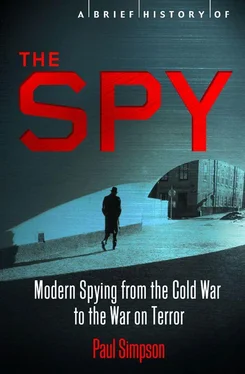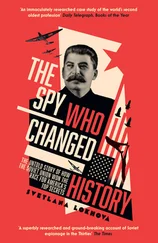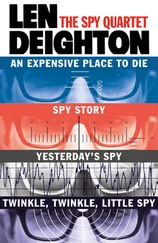Paul Simpson - A Brief History of the Spy
Здесь есть возможность читать онлайн «Paul Simpson - A Brief History of the Spy» весь текст электронной книги совершенно бесплатно (целиком полную версию без сокращений). В некоторых случаях можно слушать аудио, скачать через торрент в формате fb2 и присутствует краткое содержание. Город: London, Год выпуска: 2013, ISBN: 2013, Издательство: Constable & Robinson, Жанр: Прочая документальная литература, на английском языке. Описание произведения, (предисловие) а так же отзывы посетителей доступны на портале библиотеки ЛибКат.
- Название:A Brief History of the Spy
- Автор:
- Издательство:Constable & Robinson
- Жанр:
- Год:2013
- Город:London
- ISBN:9781780338910
- Рейтинг книги:3 / 5. Голосов: 1
-
Избранное:Добавить в избранное
- Отзывы:
-
Ваша оценка:
- 60
- 1
- 2
- 3
- 4
- 5
A Brief History of the Spy: краткое содержание, описание и аннотация
Предлагаем к чтению аннотацию, описание, краткое содержание или предисловие (зависит от того, что написал сам автор книги «A Brief History of the Spy»). Если вы не нашли необходимую информацию о книге — напишите в комментариях, мы постараемся отыскать её.
A Brief History of the Spy — читать онлайн бесплатно полную книгу (весь текст) целиком
Ниже представлен текст книги, разбитый по страницам. Система сохранения места последней прочитанной страницы, позволяет с удобством читать онлайн бесплатно книгу «A Brief History of the Spy», без необходимости каждый раз заново искать на чём Вы остановились. Поставьте закладку, и сможете в любой момент перейти на страницу, на которой закончили чтение.
Интервал:
Закладка:
A policy of harassment began: trains travelling between the non-Soviet parts of Germany and Berlin were stopped and searched; a Soviet Yak-9 fighter came too close to a British airliner, killing all aboard. On 19 June 1948, the Russians stopped all rail traffic into the city; four days later, road and barge traffic was also halted. Then they cut the electricity supplies to West Berlin. It could have been a prelude for war, but all analysis indicated that if the Western powers held firm, Stalin would eventually back down. An incredible feat of logistics ensured that the blockade of Berlin, while still materially affecting everyone within the city, never brought the Western powers near to capitulation. For ten months, a constant stream of aircraft brought supplies along the internationally agreed air corridors over East Germany, keeping the Berliners alive.
Three months before the blockade began, at a time when the Soviets were carrying out military manoeuvres and beginning their harassment, DCI Hillenkoetter briefed President Truman:
The USSR… cannot expect the US and the other Western Powers to evacuate [Berlin] voluntarily. The USSR, therefore, will probably use every means short of armed force to compel these powers to leave the city.
These devices may include additional obstruction to transport and travel to and within the city, ‘failure’ of services such as electric supply, reduction of that part of the food supply which comes from the Soviet Zone… [T]he day-to-day developments in the immediate future will test the firmness, patience, and discipline of all US personnel in Berlin.
As a prediction of the nearly year-long crisis, it couldn’t really be bettered. It certainly seemed as if Stalin wasn’t being served with nearly as good intelligence from his people in Berlin, since he fatally underestimated the resolve of the coalition, and had little option but to back down and eventually reopen the borders.
The Cold War wasn’t the only consideration for the CIA in 1948. Events in the Middle East were the focus of attention, as Jewish forces fought tooth and nail to create an independent state of Israel. On numerous occasions during that year, it seemed as if the Arab forces would deal a decisive blow to the nascent state, which had been declared on 14 May 1948, and recognized by the US and the USSR. However, the tenacity of the Jewish people — together with aid from foreign countries, sometimes in direct breach of United Nations declarations — ensured their survival. Hillenkoetter answered criticisms that the CIA hadn’t predicted the outcome by pointing out that no one could have anticipated the amount of overseas aid that Israel would receive.
What proved to be one of the biggest mistakes the early CIA would make came with regard to the Soviet atomic programme. Neither the CIA nor the FBI was fully aware of the extent of the spy rings that had been set up during the Second World War to elicit the information — although Alan Nunn May had been arrested following the Gouzenko revelations, he was proud in later life that he never betrayed any of his colleagues to the security forces. The Venona transcripts showed that there were others involved, but there wasn’t clear evidence as to whom — and without that information it was impossible to judge what could have been passed across.
Although the Western allies had tried to prevent German atomic scientists from being inducted to the Soviet programme at the end of the war, they knew that some key German personnel, including Dr Nicolaus Riehl of the Auer Company, Professor Gustav Hertz, and Professor Adolf Thiessen, were in Russian hands. Intelligence reports concluded that Germany’s foremost cyclotron constructor, as well as an expert in the biophysics of radiation, were also working for them. Four East German scientists who defected to the West in 1947 helped to fill in some of the gaps, and evidence obtained by covert CIA operatives suggested that plutonium production was taking place at Elektrostal, a small town about sixty miles east of Moscow, using material produced at the IG Farben plant near Berlin.
Unfortunately, the CIA’s own analysts didn’t pay much heed to that information, and instead relied on pre-war geological analyses which stated that the Soviet Union wouldn’t be able to threaten America’s near-monopoly on suitable ore. In October 1946, the CIA’s Office of Reports and Estimates suggested that ‘It is probable that the capability of the USSR to develop weapons based on atomic energy will be limited to the possible development of an atomic bomb to the stage of production at some time between 1950 and 1953. On this assumption, a quantity of such bombs could be produced and stockpiled by 1956.’ The ORE admitted its projections were ‘educated guesswork’ but based it on ‘the current estimate of existing Soviet scientific and industrial capabilities, taking into account the past performance of Soviet and of Soviet-controlled German scientists and technicians, our own past experience, and estimates of our own capabilities for future development and production.’ Although the information received regarding the Soviets progress brought the projected date forward to a certain extent, the earliest possible date was still being given as ‘mid-1950’ with mid-1953 being the most probable. That report was dated a mere five days before the Soviets exploded their first atomic device, nicknamed Joe-1 at Semipalatinsk, a site in north-eastern Kazakhstan, on 29 August.
Internally at the CIA, the failure to predict the timing of the test firing was described as an ‘almost total failure of conventional intelligence’ by assistant director Willard Machie. Summoned before the Joint Committee on Atomic Energy on 17 October, Hillenkoetter maintained that ‘I don’t think we were taken by surprise’ — an assertion that didn’t go down too well with the members of the committee.
‘Our estimates were not too far off,’ Hillenkoetter said, explaining that the CIA assumed that the Russians didn’t begin work on an atomic programme until after the explosion at Hiroshima in August 1945, but it was now clear that they had started in 1943 — so the ORE’s estimate of five years from start to finish was still accurate. He also noted that now the Russians had exploded a bomb, it meant that they could better correlate the various pieces of information that they had. (One Senator pointed out that even ‘the Russians themselves didn’t know that they had the bomb until it went off’, unconsciously echoing the concerns of Soviet ministers at the time, who sought reassurance that there had been the distinctive mushroom cloud before reporting to Stalin.)
At least one of the Senators present caught the mood: ‘We have not had an organisation adequate to know what is going on in the past and [the DCI] gives me no assurance that we are going to have one in the future.’
Failing to predict the rise of the Communist party and the declaration of the People’s Republic of China was another charge levelled against Hillenkoetter by the Herald Tribune . Once again this wasn’t accurate: the Agency had been repeatedly pointing out that the nationalist forces in China were disintegrating, and the rise of the Communist party under Mao Tse Tung was a corollary of that.
In the words of a later deputy DDI at the CIA, John Gannon:
[There was] a widely held but incorrect perception that the job of intelligence officers is to predict the future. That is not the case. Only God is omniscient, and only the Pope is infallible; intelligence officers are too savvy to compete in that league. Rather, the function of intelligence is to help US decision makers better understand the forces at work in any situation, the other fellow’s perspective, and the opportunities and consequences of any course of action so that US policymakers can make informed decisions.
Читать дальшеИнтервал:
Закладка:
Похожие книги на «A Brief History of the Spy»
Представляем Вашему вниманию похожие книги на «A Brief History of the Spy» списком для выбора. Мы отобрали схожую по названию и смыслу литературу в надежде предоставить читателям больше вариантов отыскать новые, интересные, ещё непрочитанные произведения.
Обсуждение, отзывы о книге «A Brief History of the Spy» и просто собственные мнения читателей. Оставьте ваши комментарии, напишите, что Вы думаете о произведении, его смысле или главных героях. Укажите что конкретно понравилось, а что нет, и почему Вы так считаете.












